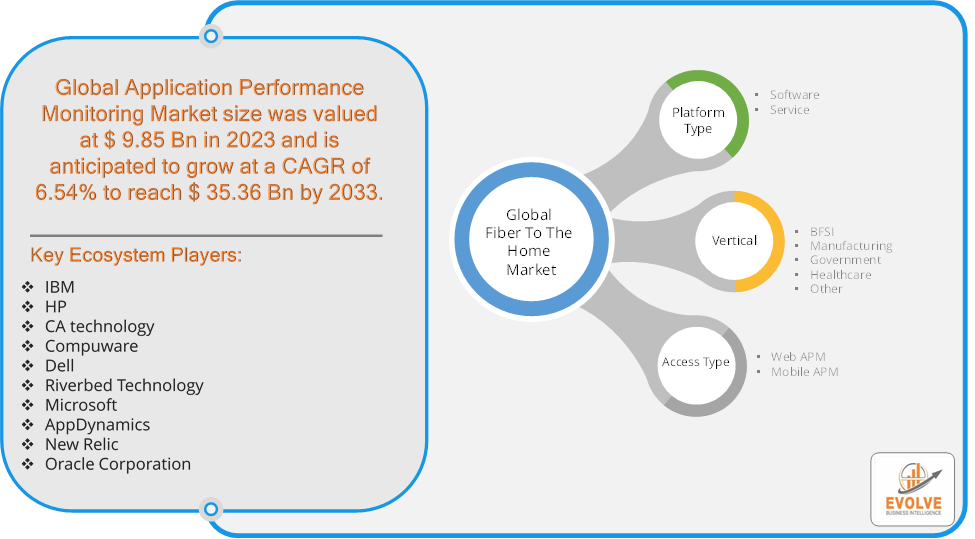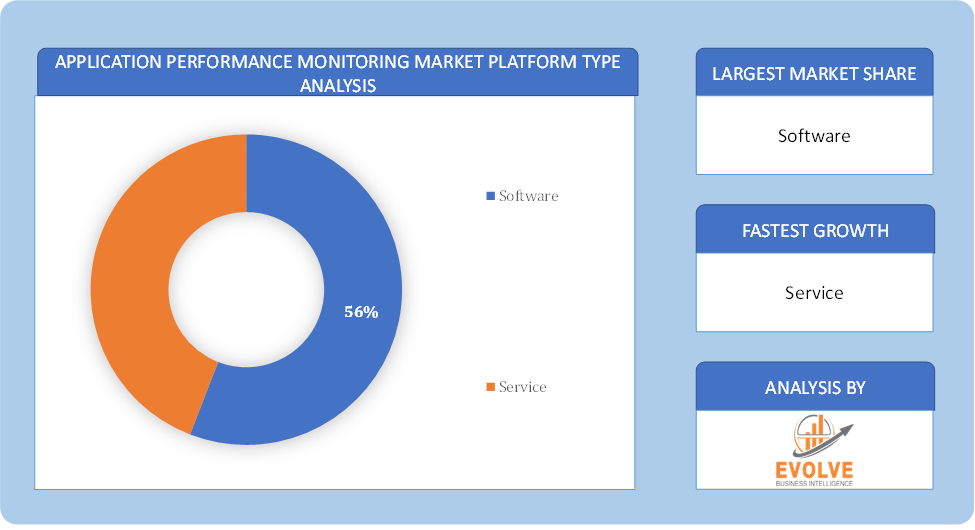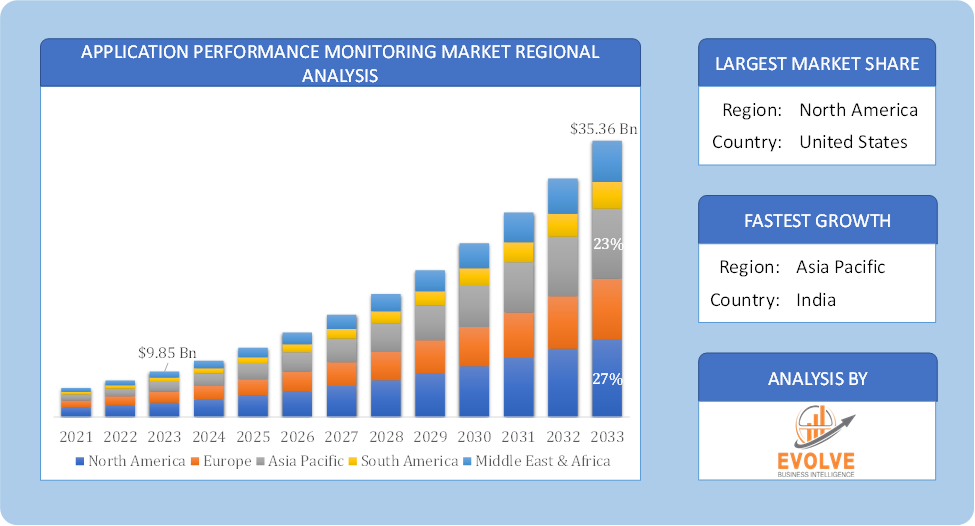Application Performance Monitoring Market Analysis and Global Forecast 2023-2033
$ 1,390.00 – $ 5,520.00Price range: $ 1,390.00 through $ 5,520.00
Application Performance Monitoring Market Research Report: Information By Platform type (Software, Service), By vertical (BFSI, Manufacturing, Government, Healthcare, Others), By access type (Web APM, Mobile APM), and by Region — Forecast till 2033
Page: 166
Application Performance Monitoring Market Overview
The Application Performance Monitoring Market Size is expected to reach USD 35.36 Billion by 2033. The Application Performance Monitoring Market industry size accounted for USD 9.85 Billion in 2023 and is expected to expand at a compound annual growth rate (CAGR) of 6.54% from 2023 to 2033. The Application Performance Monitoring (APM) Market refers to the sector of the technology industry that provides tools and solutions designed to monitor, manage, and optimize the performance of software applications. APM tools help organizations ensure that their applications are running smoothly and efficiently by tracking various performance metrics, identifying bottlenecks, and diagnosing issues.
The APM market continues to grow as organizations increasingly rely on digital applications for their operations and customer interactions.
Global Application Performance Monitoring Market Synopsis
 COVID-19 Impact Analysis
COVID-19 Impact Analysis
The COVID-19 pandemic had a significant impact on the Application Performance Monitoring (APM) Market. With the pandemic forcing many businesses to adopt remote work and digital solutions rapidly, there was a surge in the use of online platforms and applications. This increased the demand for APM tools to ensure that applications remained operational and performant. The shift to remote work required businesses to ensure that their remote-access applications and collaboration tools performed efficiently, further driving the need for APM solutions. The pandemic accelerated the adoption of hybrid and multi-cloud environments, increasing the complexity of application infrastructures. APM tools became crucial in managing performance across these diverse environments. The increased reliance on cloud services during the pandemic drove growth in the cloud-based APM market. Many organizations adopted cloud-native APM solutions to monitor applications running in cloud environments. With more users relying on digital platforms for essential services, businesses placed a greater emphasis on user experience. APM tools helped organizations monitor and optimize application performance to meet elevated user expectations. The pandemic expanded the APM market across various sectors, including healthcare, e-commerce, and financial services, as these industries saw increased digital activity and needed robust monitoring solutions.
Application Performance Monitoring Market Dynamics
The major factors that have impacted the growth of Application Performance Monitoring Market are as follows:
Drivers:
Ø Adoption of Digital Technologies
As organizations move towards digital platforms and cloud-based services, there is an increased need for APM tools to monitor and optimize application performance. The shift to cloud environments has heightened the complexity of application ecosystems, driving demand for sophisticated APM solutions. Integration of AI and ML into APM solutions enhances predictive analytics, anomaly detection, and automated issue resolution, driving market growth. The rise of DevOps practices and continuous delivery models requires APM tools that integrate with development and deployment processes to ensure application performance throughout the software lifecycle.
Restraint:
- Perception of High Costs and Sensitive Data
The cost of deploying APM solutions, including software licenses, implementation, and maintenance, can be significant, especially for small and medium-sized enterprises (SMEs). Integrating APM tools with existing IT infrastructure and applications can be costly and time-consuming, potentially deterring organizations from adopting these solutions. APM tools collect and analyze performance data that may include sensitive or proprietary information, raising concerns about data privacy and security.
Opportunity:
⮚ Growth of Digital and Remote Work Environments
The continued growth of remote work and online collaboration tools creates opportunities for APM solutions to ensure these applications perform optimally across diverse environments. As organizations continue to invest in digital transformation, APM solutions can play a key role in managing and optimizing the performance of new and existing digital applications. Investing in advanced analytics and visualization features can provide deeper insights into application performance, helping organizations make informed decisions and address issues more effectively. Offering comprehensive end-to-end visibility into application performance across all components and stages can differentiate APM solutions and attract more customers.
Application Performance Monitoring Market Segment Overview
 By Platform Type
By Platform Type
Based on Platform Type, the market is segmented based on Software and Service. The Software-based APM solutions are tools, applications, and platforms that organizations deploy to monitor and manage the performance of their applications. They include various software offerings, such as APM suites, application monitoring software, and performance analytics tools. They provide real-time insights into application performance, transaction tracing, code-level diagnostics, and user experience monitoring. They are designed to help businesses identify and resolve performance issues, optimize application performance, and enhance user satisfaction.
By Vertical
Based on Vertical, the market segment has been divided into BFSI, Manufacturing, Government, Healthcare and Other. The Manufacturing segment dominant the market
By Access Type
Based on Access Type, the market segment has been divided into Web APM and Mobile APM. The Web APM segment dominant the market. Web APM solutions focus on monitoring and optimizing the performance of web-based applications, websites, and online services accessed through web browsers. They include APM tools and services designed to analyze and improve the performance of web applications, content delivery, and user interactions on websites. They track metrics, such as page load times, server response times, render performance, and user experience, to ensure fast and reliable web application delivery.
Global Application Performance Monitoring Market Regional Analysis
Based on region, the global Application Performance Monitoring Market has been divided into North America, Europe, Asia-Pacific, the Middle East & Africa, and Latin America. North America is projected to dominate the use of the Application Performance Monitoring Market followed by the Asia-Pacific and Europe regions.
 Application Performance Monitoring North America Market
Application Performance Monitoring North America Market
North America holds a dominant position in the Application Performance Monitoring Market. North America, particularly the United States, is a leading market for APM due to its advanced technology infrastructure, high adoption rates of digital technologies, and strong presence of key APM vendors. The region’s emphasis on innovation and early adoption of emerging technologies like AI and ML enhances the growth of APM solutions and high demand from large enterprises across various sectors, including finance, healthcare, and technology, drives the APM market.
Application Performance Monitoring Asia-Pacific Market
The Asia-Pacific region has indeed emerged as the fastest-growing market for the Application Performance Monitoring Market industry. APAC is experiencing rapid growth in the APM market due to increasing digitalization, cloud adoption, and investment in IT infrastructure. Countries like India and China are significant contributors to market growth, driven by their expanding IT sectors and increasing use of digital applications. A growing number of SMEs in the region are adopting APM solutions to improve their application performance and operational efficiency.
Competitive Landscape
The global Application Performance Monitoring Market is highly competitive, with numerous players offering a wide range of software solutions. The competitive landscape is characterized by the presence of established companies, as well as emerging startups and niche players. To increase their market position and attract a wide consumer base, the businesses are employing various strategies, such as product launches, and strategic alliances.
Prominent Players:
- IBM
- HP
- CA technology
- Compuware
- Dell
- Riverbed Technology
- Microsoft
- AppDynamics
- New Relic
- Oracle Corporation
Key Development
In May 2023, New Relic Inc announced New Relic AI, the generative AI assistant for observability. New Relic AI reduces the toil of manually sifting through data, makes observability accessible to all regardless of prior experience, and unlocks insights from any telemetry data source.
In April 2021: IBM Corporation announced a definitive agreement to acquire Turbonomic, the acquisition will provide businesses with full stack application observability and management to assure performance and minimize costs using AI to optimize resources. This will ensure that they can dynamically and more efficiently assess and manage the performance of any application, anywhere.
Scope of the Report
Global Application Performance Monitoring Market, by Platform Type
- Software
- Service
Global Application Performance Monitoring Market, by Vertical
- BFSI
- Manufacturing
- Government
- Healthcare
- Other
Global Application Performance Monitoring Market, by Access Type
- Web APM
- Mobile APM
Global Application Performance Monitoring Market, by Region
- North America
- US
- Canada
- Mexico
- Europe
- UK
- Germany
- France
- Italy
- Spain
- Benelux
- Nordic
- Rest of Europe
- Asia Pacific
- China
- Japan
- South Korea
- Indonesia
- Austalia
- Malaysia
- India
- Rest of Asia Pacific
- South America
- Brazil
- Argentina
- Rest of South America
- Middle East & Africa
- Saudi Arabia
- UAE
- Egypt
- South Africa
- Rest of Middle East & Africa
| Parameters | Indicators |
|---|---|
| Market Size | 2033: USD 35.36 Billion |
| CAGR (2023-2033) | 6.54% |
| Base year | 2022 |
| Forecast Period | 2023-2033 |
| Historical Data | 2021 (2017 to 2020 On Demand) |
| Report Coverage | Revenue Forecast, Competitive Landscape, Growth Factors, and Trends |
| Key Segmentations | Platform Type, Vertical, Access type |
| Geographies Covered | North America, Europe, Asia-Pacific, South America, Middle East, Africa |
| Key Vendors | IBM, HP, CA technology, Compuware, Dell, Riverbed Technology, Microsoft, AppDynamics, New Relic and Oracle Corporation. |
| Key Market Opportunities | · Growth of Digital and Remote Work Environments · Development of Advanced Features |
| Key Market Drivers | · Adoption of Digital Technologies · Technological Advancements |
REPORT CONTENT BRIEF:
- High-level analysis of the current and future Application Performance Monitoring Market trends and opportunities
- Detailed analysis of current market drivers, restraining factors, and opportunities in the future
- Application Performance Monitoring Market historical market size for the year 2021, and forecast from 2023 to 2033
- Application Performance Monitoring Market share analysis at each product level
- Competitor analysis with detailed insight into its product segment, Government & Defense strength, and strategies adopted.
- Identifies key strategies adopted including product launches and developments, mergers and acquisitions, joint ventures, collaborations, and partnerships as well as funding taken and investment done, among others.
- To identify and understand the various factors involved in the global Application Performance Monitoring Market affected by the pandemic
- To provide a detailed insight into the major companies operating in the market. The profiling will include the Government & Defense health of the company’s past 2-3 years with segmental and regional revenue breakup, product offering, recent developments, SWOT analysis, and key strategies.
Frequently Asked Questions (FAQ)
What is the study period of this market?
The study period of the global Application Performance Monitoring Market is 2021- 2033
What is the growth rate of the global Application Performance Monitoring Market?
The global Application Performance Monitoring Market is growing at a CAGR of 4.41% over the next 10 years
Which region has the highest growth rate in the market of Application Performance Monitoring Market?
Asia Pacific is expected to register the highest CAGR during 2023-2033
Which region has the largest share of the global Application Performance Monitoring Market?
North America holds the largest share in 2022
Who are the key players in the global Application Performance Monitoring Market?
IBM, HP, CA technology, Compuware, Dell, Riverbed Technology, Microsoft, AppDynamics, New Relic and Oracle Corporation are the major companies operating in the market.
Do you offer Post Sale Support?
Yes, we offer 16 hours of analyst support to solve the queries
Do you sell particular sections of a report?
Yes, we provide regional as well as country-level reports. Other than this we also provide a sectional report. Please get in contact with our sales representatives.
Press Release

Global Pharmaceutical Manufacturing Market to Reach $1.38 Trillion by 2035 with 7.35% CAGR, New Research Shows

The Global Mammography Market Is Estimated To Record a CAGR of Around 10.29% During The Forecast Period

Glue Stick Market to Reach USD 2.35 Billion by 2034

Podiatry Service Market to Reach USD 11.88 Billion by 2034

Microfluidics Technology Market to Reach USD 32.58 Billion by 2034

Ferric Chloride Market to Reach USD 10.65 Billion by 2034

Family Practice EMR Software Market to Reach USD 21.52 Billion by 2034

Electric Hairbrush Market to Reach USD 15.95 Billion by 2034

Daily Bamboo Products Market to Reach USD 143.52 Billion by 2034

Cross-border E-commerce Logistics Market to Reach USD 112.65 Billion by 2034
Table of Content
CHAPTER 1. Executive Summary CHAPTER 2. Scope of the Study 2.1. Market Definition 2.2. Market Scope & Segmentation 2.2.1. Objective of Report CHAPTER 3. Evolve BI Methodology 3.1. Data Collection & Validation Approach 3.2. Market Size Estimation and Forecast CHAPTER 4. Exclusive Analysis 4.1. Market Opportunity Score 4.1.1. Platform Type Segement – Market Opportunity Score 4.1.2. Vertical Segment – Market Opportunity Score 4.1.3. Access Type Segment – Market Opportunity Score 4.2. Key Market Influencing Indicators CHAPTER 5. Market Insights and Trends 5.1. Value Chain Analysis 5.1.1. Raw Material 5.1.2. Manufacturing Process 5.1.3. Distribution Channel 5.1.4. End User 5.2. Porter’s Five Forces Analysis 5.2.1. Bargaining Power of Buyers 5.2.2. Bargaining Power of Suppliers 5.2.3. Threat of New Entrant 5.2.4. Threat of Substitute 5.2.5. Industry Rivalry 5.3. COVID-19 Impact and Post COVID Scenario on Application Performance Monitoring Market 5.3.1. Impact of COVID-19 5.3.2. Government Support and Industry Revival Policies 5.3.3. Measures Taken by Companies to Mitigate Negative Impact 5.3.4. Post COVID Trend CHAPTER 6. Market Dynamics 6.1. Introduction 6.2. Drivers 6.2.1. Driver 1 6.2.2. Driver 2 6.2.3. Driver 3 6.3. Restraints 6.3.1. Restraint 1 6.3.2. Restraint 2 6.4. Opportunity 6.4.1. Opportunity 1 CHAPTER 7. Application Performance Monitoring Market, By Platform Type 7.1. Introduction 7.1.1. Software 7.1.2. Services CHAPTER 8 Application Performance Monitoring Market, By Vertical 8.1. Introduction 8.1.1. BFSI 8.1.2. Manufacturing 8.1.3. Government 8.1.4. Healthcare 8.1.5. Other CHAPTER 9. Application Performance Monitoring Market, By Access Type 9.1. Introduction 9.1.1. Web APM 9.1.2 Mobile APM CHAPTER 10. Application Performance Monitoring Market, By Region 10.1. Introduction 10.2. NORTH AMERICA 10.2.1. North America: Market Size and Forecast, By Country, 2023 – 2033 ($ Million) 10.2.2. North America: Market Size and Forecast, By Platform Type, 2023 – 2033 ($ Million) 10.2.3. North America: Market Size and Forecast, By Vertical, 2023 – 2033 ($ Million) 10.2.4. North America: Market Size and Forecast, By Access Type, 2023 – 2033 ($ Million) 10.2.5. US 10.2.5.1. US: Market Size and Forecast, By Platform Type, 2023 – 2033 ($ Million) 10.2.5.2. US: Market Size and Forecast, By Vertical, 2023 – 2033 ($ Million) 10.2.5.3. US: Market Size and Forecast, By Access Type, 2023 – 2033 ($ Million) 10.2.6. CANADA 10.2.6.1. Canada: Market Size and Forecast, By Platform Type, 2023 – 2033 ($ Million) 10.2.6.2. Canada: Market Size and Forecast, By Vertical, 2023 – 2033 ($ Million) 10.2.6.3. Canada: Market Size and Forecast, By Access Type, 2023 – 2033 ($ Million) 10.2.7. MEXICO 10.2.7.1. Mexico: Market Size and Forecast, By Platform Type, 2023 – 2033 ($ Million) 10.2.7.2. Mexico: Market Size and Forecast, By Vertical, 2023 – 2033 ($ Million) 10.2.7.3. Mexico: Market Size and Forecast, By Access Type, 2023 – 2033 ($ Million) 10.3. Europe 10.3.1. Europe: Market Size and Forecast, By Country, 2023 – 2033 ($ Million) 10.3.2. Europe: Market Size and Forecast, By Platform Type, 2023 – 2033 ($ Million) 10.3.3. Europe: Market Size and Forecast, By Vertical, 2023 – 2033 ($ Million) 10.3.4. Europe: Market Size and Forecast, By Access Type, 2023 – 2033 ($ Million) 10.3.5. U.K. 10.3.5.1. U.K.: Market Size and Forecast, By Platform Type, 2023 – 2033 ($ Million) 10.3.5.2. U.K.: Market Size and Forecast, By Vertical, 2023 – 2033 ($ Million) 10.3.5.3. U.K.: Market Size and Forecast, By Access Type, 2023 – 2033 ($ Million) 10.3.6. GERMANY 10.3.6.1. Germany: Market Size and Forecast, By Platform Type, 2023 – 2033 ($ Million) 10.3.6.2. Germany: Market Size and Forecast, By Vertical, 2023 – 2033 ($ Million) 10.3.6.3. Germany: Market Size and Forecast, By Access Type, 2023 – 2033 ($ Million) 10.3.7. FRANCE 10.3.7.1. France: Market Size and Forecast, By Platform Type, 2023 – 2033 ($ Million) 10.3.7.2. France: Market Size and Forecast, By Vertical, 2023 – 2033 ($ Million) 10.3.7.3. France: Market Size and Forecast, By Access Type, 2023 – 2033 ($ Million) 10.3.8. ITALY 10.3.8.1. Italy: Market Size and Forecast, By Platform Type, 2023 – 2033 ($ Million) 10.3.8.2. Italy: Market Size and Forecast, By Vertical, 2023 – 2033 ($ Million) 10.3.8.3. Italy: Market Size and Forecast, By Access Type, 2023 – 2033 ($ Million) 10.3.9. SPAIN 10.3.9.1. Spain: Market Size and Forecast, By Platform Type, 2023 – 2033 ($ Million) 10.3.9.2. Spain: Market Size and Forecast, By Vertical, 2023 – 2033 ($ Million) 10.3.9.3. Spain: Market Size and Forecast, By Access Type, 2023 – 2033 ($ Million) 10.3.10. BENELUX 10.3.10.1. BeNeLux: Market Size and Forecast, By Platform Type, 2023 – 2033 ($ Million) 10.3.10.2. BeNeLux: Market Size and Forecast, By Vertical, 2023 – 2033 ($ Million) 10.3.10.3. BeNeLux: Market Size and Forecast, By Access Type, 2023 – 2033 ($ Million) 10.3.11. RUSSIA 10.3.11.1. Russia: Market Size and Forecast, By Platform Type, 2023 – 2033 ($ Million) 10.3.11.2. Russia: Market Size and Forecast, By Vertical, 2023 – 2033 ($ Million) 10.3.11.3. Russia: Market Size and Forecast, By Access Type, 2023 – 2033 ($ Million) 10.3.12. REST OF EUROPE 10.3.12.1. Rest of Europe: Market Size and Forecast, By Platform Type, 2023 – 2033 ($ Million) 10.3.12.2. Rest of Europe: Market Size and Forecast, By Vertical, 2023 – 2033 ($ Million) 10.3.12.3. Rest of Europe: Market Size and Forecast, By Access Type, 2023 – 2033 ($ Million) 10.4. Asia Pacific 10.4.1. Asia Pacific: Market Size and Forecast, By Country, 2023 – 2033 ($ Million) 10.4.2. Asia Pacific: Market Size and Forecast, By Platform Type, 2023 – 2033 ($ Million) 10.4.3. Asia Pacific: Market Size and Forecast, By Vertical, 2023 – 2033 ($ Million) 10.4.4. Asia Pacific: Market Size and Forecast, By Access Type, 2023 – 2033 ($ Million) 10.4.5. CHINA 10.4.5.1. China: Market Size and Forecast, By Platform Type, 2023 – 2033 ($ Million) 10.4.5.2. China: Market Size and Forecast, By Vertical, 2023 – 2033 ($ Million) 10.4.5.3. China: Market Size and Forecast, By Access Type, 2023 – 2033 ($ Million) 10.4.6. JAPAN 10.4.6.1. Japan: Market Size and Forecast, By Platform Type, 2023 – 2033 ($ Million) 10.4.6.2. Japan: Market Size and Forecast, By Vertical, 2023 – 2033 ($ Million) 10.4.6.3. Japan: Market Size and Forecast, By Access Type, 2023 – 2033 ($ Million) 10.4.7. INDIA 10.4.7.1. India: Market Size and Forecast, By Platform Type, 2023 – 2033 ($ Million) 10.4.7.2. India: Market Size and Forecast, By Vertical, 2023 – 2033 ($ Million) 10.4.7.3. India: Market Size and Forecast, By Access Type, 2023 – 2033 ($ Million) 10.4.8. SOUTH KOREA 10.4.8.1. South Korea: Market Size and Forecast, By Platform Type, 2023 – 2033 ($ Million) 10.4.8.2. South Korea: Market Size and Forecast, By Vertical, 2023 – 2033 ($ Million) 10.4.8.3. South Korea: Market Size and Forecast, By Access Type, 2023 – 2033 ($ Million) 10.4.9. THAILAND 10.4.9.1. Thailand: Market Size and Forecast, By Platform Type, 2023 – 2033 ($ Million) 10.4.9.2. Thailand: Market Size and Forecast, By Vertical, 2023 – 2033 ($ Million) 10.4.9.3. Thailand: Market Size and Forecast, By Access Type, 2023 – 2033 ($ Million) 10.4.10. INDONESIA 10.4.10.1. Indonesia: Market Size and Forecast, By Platform Type, 2023 – 2033 ($ Million) 10.4.10.2. Indonesia: Market Size and Forecast, By Vertical, 2023 – 2033 ($ Million) 10.4.10.3. Indonesia: Market Size and Forecast, By Access Type, 2023 – 2033 ($ Million) 10.4.11. MALAYSIA 10.4.11.1. Malaysia: Market Size and Forecast, By Platform Type, 2023 – 2033 ($ Million) 10.4.11.2. Malaysia: Market Size and Forecast, By Vertical, 2023 – 2033 ($ Million) 10.4.11.3. Malaysia: Market Size and Forecast, By Access Type, 2023 – 2033 ($ Million) 10.4.12. AUSTRALIA 10.4.12.1. Australia: Market Size and Forecast, By Platform Type, 2023 – 2033 ($ Million) 10.4.12.2. Australia: Market Size and Forecast, By Vertical, 2023 – 2033 ($ Million) 10.4.12.3. Australia: Market Size and Forecast, By Access Type, 2023 – 2033 ($ Million) 10.4.13. REST FO ASIA PACIFIC 10.4.13.1. Rest fo Asia Pacific: Market Size and Forecast, By Platform Type, 2023 – 2033 ($ Million) 10.4.13.2. Rest fo Asia Pacific: Market Size and Forecast, By Vertical, 2023 – 2033 ($ Million) 10.4.13.3. Rest fo Asia Pacific: Market Size and Forecast, By Access Type, 2023 – 2033 ($ Million) 10.5. South America 10.5.1. South America: Market Size and Forecast, By Country, 2023 – 2033 ($ Million) 10.5.2. South America: Market Size and Forecast, By Platform Type, 2023 – 2033 ($ Million) 10.5.3. South America: Market Size and Forecast, By Vertical, 2023 – 2033 ($ Million) 10.5.4. South America: Market Size and Forecast, By Access Type, 2023 – 2033 ($ Million) 10.5.5. BRAZIL 10.5.5.1. Brazil: Market Size and Forecast, By Platform Type, 2023 – 2033 ($ Million) 10.5.5.2. Brazil: Market Size and Forecast, By Vertical, 2023 – 2033 ($ Million) 10.5.5.3. Brazil: Market Size and Forecast, By Access Type, 2023 – 2033 ($ Million) 10.5.6. ARGENTINA 10.5.6.1. Argentina: Market Size and Forecast, By Platform Type, 2023 – 2033 ($ Million) 10.5.6.2. Argentina: Market Size and Forecast, By Vertical, 2023 – 2033 ($ Million) 10.5.6.3. Argentina: Market Size and Forecast, By Access Type, 2023 – 2033 ($ Million) 10.5.7. REST OF SOUTH AMERICA 10.5.7.1. Rest of South America: Market Size and Forecast, By Platform Type, 2023 – 2033 ($ Million) 10.5.7.2. Rest of South America: Market Size and Forecast, By Vertical, 2023 – 2033 ($ Million) 10.5.7.3. Rest of South America: Market Size and Forecast, By Access Type, 2023 – 2033 ($ Million) 10.6. Middle East & Africa 10.6.1. Middle East & Africa: Market Size and Forecast, By Country, 2023 – 2033 ($ Million) 10.6.2. Middle East & Africa: Market Size and Forecast, By Platform Type, 2023 – 2033 ($ Million) 10.6.3. Middle East & Africa: Market Size and Forecast, By Vertical, 2023 – 2033 ($ Million) 10.6.4. Middle East & Africa: Market Size and Forecast, By Access Type, 2023 – 2033 ($ Million) 10.6.5. SAUDI ARABIA 10.6.5.1. Saudi Arabia: Market Size and Forecast, By Platform Type, 2023 – 2033 ($ Million) 10.6.5.2. Saudi Arabia: Market Size and Forecast, By Vertical, 2023 – 2033 ($ Million) 10.6.5.3. Saudi Arabia: Market Size and Forecast, By Access Type, 2023 – 2033 ($ Million) 10.6.6. UAE 10.6.6.1. UAE: Market Size and Forecast, By Platform Type, 2023 – 2033 ($ Million) 10.6.6.2. UAE: Market Size and Forecast, By Vertical, 2023 – 2033 ($ Million) 10.6.6.3. UAE: Market Size and Forecast, By Access Type, 2023 – 2033 ($ Million) 10.6.7. EGYPT 10.6.7.1. Egypt: Market Size and Forecast, By Platform Type, 2023 – 2033 ($ Million) 10.6.7.2. Egypt: Market Size and Forecast, By Vertical, 2023 – 2033 ($ Million) 10.6.7.3. Egypt: Market Size and Forecast, By Access Type, 2023 – 2033 ($ Million) 10.6.8. SOUTH AFRICA 10.6.8.1. South Africa: Market Size and Forecast, By Platform Type, 2023 – 2033 ($ Million) 10.6.8.2. South Africa: Market Size and Forecast, By Vertical, 2023 – 2033 ($ Million) 10.6.8.3. South Africa: Market Size and Forecast, By Access Type, 2023 – 2033 ($ Million) 10.6.9. REST OF MIDDLE EAST & AFRICA 10.6.9.1. Rest of Middle East & Africa: Market Size and Forecast, By Platform Typess, 2023 – 2033 ($ Million) 10.6.9.2. Rest of Middle East & Africa: Market Size and Forecast, By Vertical, 2023 – 2033 ($ Million) 10.6.9.3. Rest of Middle East & Africa: Market Size and Forecast, By Access Type, 2023 – 2033 ($ Million) CHAPTER 12. Competitive Landscape 12.1. Competitior Benchmarking 2023 12.2. Market Share Analysis 12.3. Key Developments Analysis By Top 5 Companies 12.4. Market Share Acquisition Strategies: Analysis of Key Approaches Employed by Top Players CHAPTER 13. Company Profiles 13.1. IBM 13.1.1. Hanon Systems 13.1.2. Financial Analysis 13.1.2.1. Business Segment Revenue, 2020, 2021, 2022, $ Million 13.1.2.2. Geographic Revenue Mix, 2022 (% Share) 13.1.3. Product Portfolio 13.1.4. Recent Development and Strategies Adopted 13.1.5. SWOT Analysis 13.2. HP 13.3. CA technology 13.4. Compuware 13.5. Dell 13.6. Riverbed Technology 13.7. Microsoft 13.8. AppDynamics 13.9 New Relic 13.10 Oracle Corporation
Connect to Analyst
Research Methodology



 Application Performance Monitoring North America Market
Application Performance Monitoring North America Market

